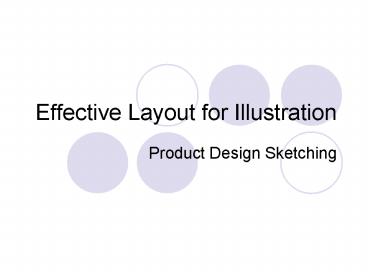Effective Layout for Illustration - PowerPoint PPT Presentation
1 / 28
Title:
Effective Layout for Illustration
Description:
Effective Layout for Illustration. Product Design Sketching ... There may be certain common conventions that guide the viewer in reading the illustration ... – PowerPoint PPT presentation
Number of Views:51
Avg rating:3.0/5.0
Title: Effective Layout for Illustration
1
Effective Layout for Illustration
- Product Design Sketching
2
Characteristics of Product Presentation
- Not very stylistic when compared to other design
disciplines - Allowance of certain level of vagueness and
uncertainties during earlier stages of the
product design process - Increasing level of realistic sense towards the
later stage of the projects, especially at the
pitching stage - Use of limited graphical instruments, which only
serve to organize but seldom dominate the
presentation - Great focus on how the product is used
3
Major Considerations
- Focus of Interest
- Prominence of an object (due to size, tone or
color) may attract first attention and thereby
determine how the viewer looks at an illustration - Common Conventions and Notations
- There may be certain common conventions that
guide the viewer in reading the illustration - Reading Sequence
- Sufficient visual hints should be given to
suggest a visual path, and thereby prompt the
viewer your intended reading sequence
4
Guiding Principles
- Visuals in a verbal design presentation should
- Support your communication objective
- Enhance your verbal message, not distract from it
- Set tone and emotional contents of verbal message
with the use of colors and images - Be succinct but adequate to convey the necessary
information
5
Use of Text
- Avoid too much textual information
- Use different font sizes to suggest hierarchy of
importance - Headings or title texts should be legible from a
distance - Check you spelling before outputting your boards!
6
Universal ConventionFrom the Upper Left
- Where no explicit hint is given, it is natural
for a viewer to start reading a series of
illustrations from the upper left - But then, it would become uncertain as to which
direction to proceed
7
(No Transcript)
8
(No Transcript)
9
Gestalt PrincipleProximity
- One way to make the reading sequence obvious is
to apply the proximity principle
start
10
(No Transcript)
11
(No Transcript)
12
Gestalt PrincipleProximity
- Another example of applying the proximity
principle
start
13
Human IntuitionClockwise Notation
- When drawings are organized in a circular manner,
it is by intuition that the viewer will look at
them in a clockwise direction starting from the
12 oclock position
start
14
(No Transcript)
15
(No Transcript)
16
Beyond Intuition
- If however it is intended to be read with a
different starting point or in different
direction, visual hint(s) may be added to prompt
the viewer
start
17
Human Intuition From Big to Small
- Sometimes a larger drawing is used to portrait
the overall outlook of the product (e.g. an
exploded rendered view). Its larger size may have
dominating effect on the reading sequence
start
18
(No Transcript)
19
Cultural Factor
- Some language systems adopt a right to left and
top to bottom reading convention - Special attention should be given to using such
layout for international readers, who may find
this sequence confusing
20
(No Transcript)
21
(No Transcript)
22
Equivocal Layout
- As a rule-of-thumb, avoid using layout that lacks
visual hint or that is against human intuition
for graphical illustration of event sequence
?
23
(No Transcript)
24
(No Transcript)
25
Two-board Presentation
26
(No Transcript)
27
(No Transcript)
28
(No Transcript)































